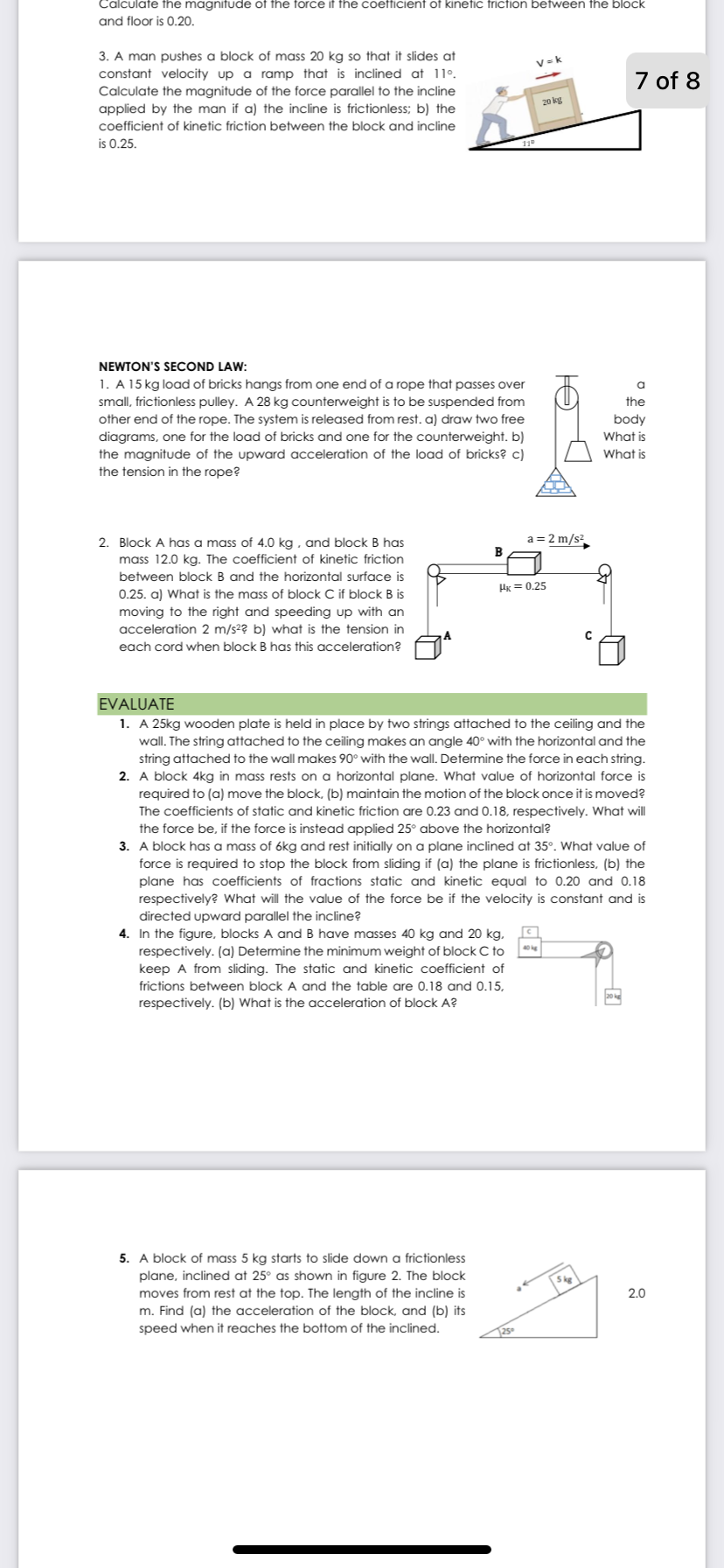5. A block of mass 5 kg starts to slide down a frictionless plane, inclined at 25° as shown in figure 2. The block moves from rest at the top. The length of the incline is m. Find (a) the acceleration of the block, and (b) its speed when it reaches the bottom of the inclined. Sk 2.0
5. A block of mass 5 kg starts to slide down a frictionless plane, inclined at 25° as shown in figure 2. The block moves from rest at the top. The length of the incline is m. Find (a) the acceleration of the block, and (b) its speed when it reaches the bottom of the inclined. Sk 2.0
University Physics Volume 1
18th Edition
ISBN:9781938168277
Author:William Moebs, Samuel J. Ling, Jeff Sanny
Publisher:William Moebs, Samuel J. Ling, Jeff Sanny
Chapter5: Newton's Law Of Motion
Section: Chapter Questions
Problem 78AP: A sailboat has a mass of 1.50103kg and is acted on by a force of 2.00103N toward the east, while the...
Related questions
Question
I need answer for evaluate #5

Transcribed Image Text:Calculate the magnifude of the force if the coefficienf of kinefic fricfion between the block
and floor is 0.20.
3. A man pushes a block of mass 20 kg so that it slides at
constant velocity up a ramp that is inclined at 11°.
V = k
7 of 8
Calculate the magnitude of the force parallel to the incline
applied by the man if a) the incline is frictionless; b) the
20 kg
coefficient of kinetic friction between the block and incline
is 0.25.
NEWTON'S SECOND LAW:
1. A 15 kg load of bricks hangs from one end of a rope that passes over
small, frictionless pulley. A 28 kg counterweight is to be suspended from
other end of the rope. The system is released from rest. a) draw two free
the
body
What is
diagrams, one for the load of bricks and one for the counterweight. b)
the magnitude of the upward acceleration of the load of bricks? c)
the tension in the rope?
What is
2. Block A has a mass of 4.0 kg , and block B has
a = 2 m/s?
В
mass 12.0 kg. The coefficient of kinetic friction
between block B and the horizontal surface is
Hg = 0.25
0.25. a) What is the mass of block C if block B is
moving to the right and speeding up with an
acceleration 2 m/s2? b) what is the tension in
each cord when block B has this acceleration?
EVALUATE
1. A 25kg wooden plate is held in place by two strings attached to the ceiling and the
wall. The string attached to the ceiling makes an angle 40° with the horizontal and the
string attached to the wall makes 90° with the wall. Determine the force in each string.
2. A block 4kg in mass rests on a horizontal plane. What value of horizontal force is
required to (a) move the block, (b) maintain the motion of the block once it is moved?
The coefficients of static and kinetic friction are 0.23 and 0.18, respectively. What will
the force be, if the force is instead applied 25° above the horizontal?
3. A block has a mass of 6kg and rest initially on a plane inclined at 35°. What value of
force is required to stop the block from sliding if (a) the plane is frictionless, (b) the
plane has coefficients of fractions static and kinetic equal to 0.20 and 0.18
respectively? What will the value of the force be if the velocity is constant and is
directed upward parallel the incline?
4. In the figure, blocks A and B have masses 40 kg and 20 kg,
respectively. (a) Detemine the minimum weight of block C to
keep A from sliding. The static and kinetic coefficient of
frictions between block A and the table are 0.18 and 0.15,
20
respectively. (b) What is the acceleration of block A?
5. A block of mass 5 kg starts to slide down a frictionless
plane, inclined at 25° as shown in figure 2. The block
moves from rest at the top. The length of the incline is
m. Find (a) the acceleration of the block, and (b) its
speed when it reaches the bottom of the inclined.
2.0
125
Expert Solution
This question has been solved!
Explore an expertly crafted, step-by-step solution for a thorough understanding of key concepts.
Step by step
Solved in 2 steps with 1 images

Knowledge Booster
Learn more about
Need a deep-dive on the concept behind this application? Look no further. Learn more about this topic, physics and related others by exploring similar questions and additional content below.Recommended textbooks for you

University Physics Volume 1
Physics
ISBN:
9781938168277
Author:
William Moebs, Samuel J. Ling, Jeff Sanny
Publisher:
OpenStax - Rice University

University Physics Volume 1
Physics
ISBN:
9781938168277
Author:
William Moebs, Samuel J. Ling, Jeff Sanny
Publisher:
OpenStax - Rice University